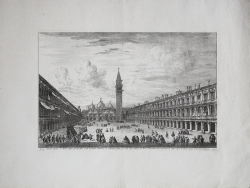- New




| Reference: | A52125 |
| Author | Michele MARIESCHI |
| Year: | 1738 ca. |
| Measures: | 447 x 300 mm |



| Reference: | A52125 |
| Author | Michele MARIESCHI |
| Year: | 1738 ca. |
| Measures: | 447 x 300 mm |
Forum Maius D. Marci aliter prospectum cum eiusdem Basilica in extrema parte, nec non cum aedibus D. Marci Procuratorum ad dexteram, vulgo novis, et alteris, vulgo veteribus ad laevam.
The Piazza San Marco looking towards the Basilica and Campanile, with the buildings of the Procuratie on either side.
Etching, 1738 circa, lettered with title, and in bottom right corner 'Michl. Marieschi delt. et incit.'
From the series: Magnificentiores Selectioresque Urbis Venetiarum Prospectus.
Example of the third state of four described by Succi, with the number 4 at lower left.
A very good impression, printed on contemporary laid paper with “three moons” watermark, full margins, excellent condition.
The album of views of Venice was a great success and was reprinted until the plates ran out. The title page, dated MDCCXLI, states that the collection consists of sixteen views (in addition to the title page and dedication); four plates were added in 1742.
In the inventory of Marieschi's assets, compiled on April 18, 1743, at the request of his widow and heir Angela Fontana, under the heading "Books" we read: : Libri d'Architettura corpi quarantaquattro di veduta in libro, sciolti di carte dieciotto l'uno fatti dal q.m sopradetto Marieschi [Architectural books, forty-four sets of views in a book, each containing eighteen sheets, made by the aforementioned Marieschi] followed by the entry Carte di vedute sciolte N.º 416 [416 single sheets of views]. From the description, it can be deduced that the first edition included, in perfect accordance with the title page, eighteen prints, namely the sixteen views, plus the title page and dedication. The other four views, completed between 1741 and 1742, were generically inventoried among the 416 loose printed views.
Bibliografia
D. Succi, La Serenissima nello Specchi di Rame, pp. 238-257, n. 10, III/IV.
Michele MARIESCHI (Venezia,1710 - Venezia, 18 Gennaio 1743)
|
Italian painter and engraver. His first biographers, Orlandi and Guarienti (1753), stated that Marieschi worked in Germany early in his career and then returned to Venice, where he established himself as a painter of ‘beautiful views of the Grand Canal, and of churches and palaces’. Yet there is no other evidence for this journey and Marieschi’s early training remains problematic. It seems likely that he began his career as a stage designer: his first recorded activity, in 1731, was the preparation, on behalf of the impresario Francesco Tasso, of the setting for the Venetian celebration of Carnival Thursday in the Piazzetta. He then, influenced by Marco Ricci and Luca Carlevaris, began to paint capriccios and vedute. His early capriccios, such as the pair Capriccio with Classical Ruins and Bridge and Capriccio with Roman Arch and Encampment (mid-1730s; Naples, Mus. Civ. Gaetano Filangieri), are indebted to Ricci, although they lack his solemnity and magnificence. Marieschi’s blend of medieval and Classical ruins in a serene Venetian landscape is more picturesque and romantic. Marieschi began to paint vedute having been encouraged by Canaletto’s great success with the genre; examples such as the S Maria della Salute (1733–5; Paris, Louvre), the Piazzetta dei Leoni and the Grand Canal at Ca’ Pesaro are distinguished from Canaletto’s work by their exaggerated perspective, more atmospheric colour and the spirited handling of the small figures. Two capriccios, the Town on a River with Rapids (London, N.G.) and the Town on a River with Shipping (London, N.G.), both charmingly picturesque scenes with watermills and crumbling towers, date from the mid-1730s. Marieschi began to etch in the 1730s, and his theatrical setting, A Palace Courtyard, is the only direct evidence of his work as a stage designer.
|
Michele MARIESCHI (Venezia,1710 - Venezia, 18 Gennaio 1743)
|
Italian painter and engraver. His first biographers, Orlandi and Guarienti (1753), stated that Marieschi worked in Germany early in his career and then returned to Venice, where he established himself as a painter of ‘beautiful views of the Grand Canal, and of churches and palaces’. Yet there is no other evidence for this journey and Marieschi’s early training remains problematic. It seems likely that he began his career as a stage designer: his first recorded activity, in 1731, was the preparation, on behalf of the impresario Francesco Tasso, of the setting for the Venetian celebration of Carnival Thursday in the Piazzetta. He then, influenced by Marco Ricci and Luca Carlevaris, began to paint capriccios and vedute. His early capriccios, such as the pair Capriccio with Classical Ruins and Bridge and Capriccio with Roman Arch and Encampment (mid-1730s; Naples, Mus. Civ. Gaetano Filangieri), are indebted to Ricci, although they lack his solemnity and magnificence. Marieschi’s blend of medieval and Classical ruins in a serene Venetian landscape is more picturesque and romantic. Marieschi began to paint vedute having been encouraged by Canaletto’s great success with the genre; examples such as the S Maria della Salute (1733–5; Paris, Louvre), the Piazzetta dei Leoni and the Grand Canal at Ca’ Pesaro are distinguished from Canaletto’s work by their exaggerated perspective, more atmospheric colour and the spirited handling of the small figures. Two capriccios, the Town on a River with Rapids (London, N.G.) and the Town on a River with Shipping (London, N.G.), both charmingly picturesque scenes with watermills and crumbling towers, date from the mid-1730s. Marieschi began to etch in the 1730s, and his theatrical setting, A Palace Courtyard, is the only direct evidence of his work as a stage designer.
|